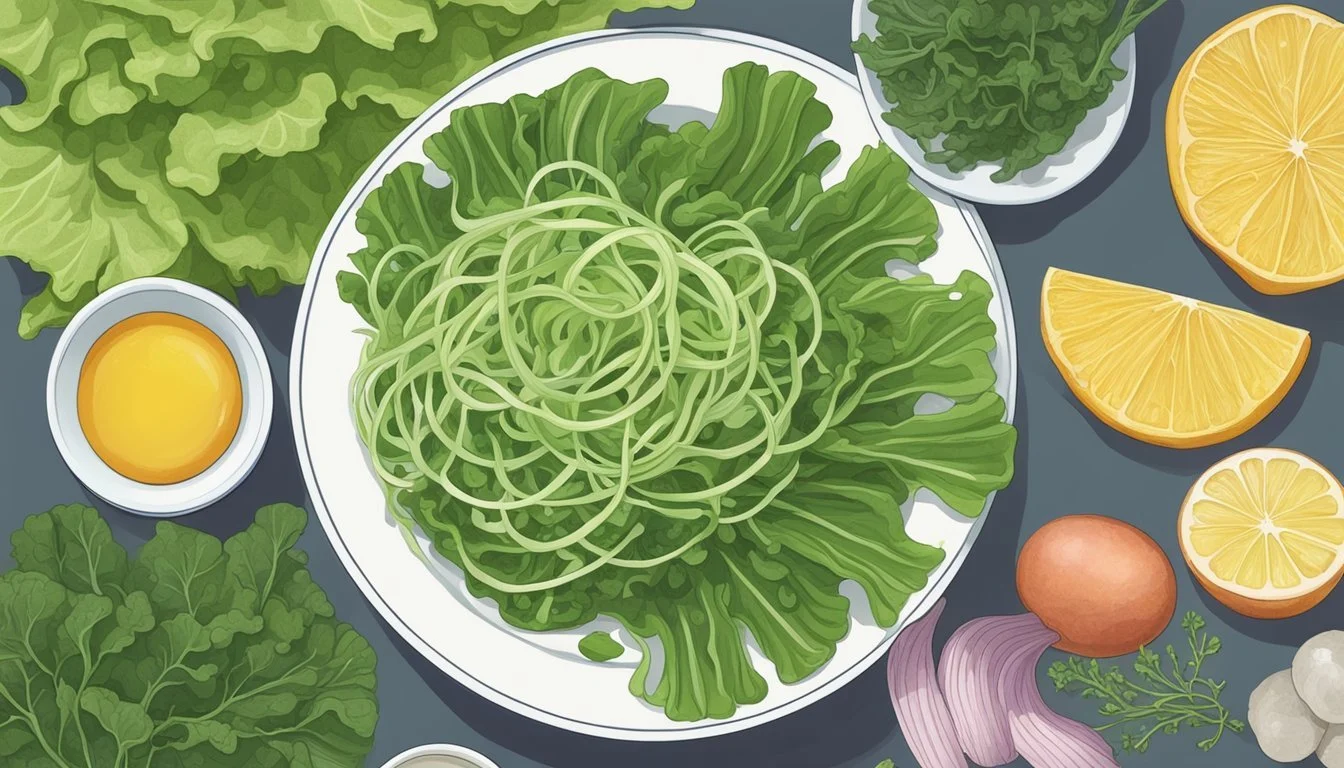Can Diabetics Eat Sea Lettuce?
Nutritional Insights and Health Benefits
Managing diabetes requires careful attention to diet, making it essential to explore the suitability of various foods. Sea lettuce, a type of green seaweed, garners interest due to its nutritional profile. People with diabetes often seek nutrient-rich, low-carbohydrate options, and sea lettuce fits this description.
Sea lettuce is packed with vitamins, minerals, and antioxidants. Importantly, it has minimal impact on blood sugar levels, making it a promising addition to the diabetic diet. Its low carbohydrate content ensures that it won’t cause significant spikes in glucose.
Incorporating sea lettuce into meals can provide essential nutrients without the added risk of high blood sugar. This makes sea lettuce not only a healthy choice but also a practical one for diabetes management.
Understanding Diabetes and Diet
Diabetes management heavily relies on dietary choices. The foods consumed can significantly affect blood glucose levels, which is critical for those with diabetes. Nutrient-rich vegetables play a vital role in stabilizing blood sugar and providing essential vitamins and minerals.
Impact of Diet on Blood Glucose Levels
For individuals with diabetes, monitoring blood glucose levels is crucial. Consuming high-carbohydrate foods can lead to spikes in blood sugar. Hence, a diet with a balance of macronutrients is essential to avoid hyperglycemia.
Carbohydrates, proteins, and fats all influence blood sugar differently. Non-starchy vegetables, for example, have low carbohydrate content. This makes them ideal for large portions without a major impact on blood glucose levels. Foods with a high glycemic index should be limited as they cause rapid increases in blood sugar.
Importance of Nutrient-Rich Vegetables
Vegetables, especially non-starchy ones like lettuce and sea lettuce, are foundational in a diabetes-friendly diet. They are low in calories and carbohydrates but rich in essential nutrients. These vegetables can help manage weight and provide fibers that aid in digestion and blood sugar management.
Leafy greens, such as lettuce, offer essential vitamins like A, C, and K. They also provide antioxidants, which protect against cellular damage. Incorporating a variety of vegetables ensures a broader intake of nutrients, contributing to better overall health and better control of diabetes.
Exploring Sea Lettuce
Sea lettuce, known scientifically as Ulva lactuca, offers a wealth of nutritional benefits, which are particularly advantageous for individuals managing diabetes. Its rich content of essential nutrients and fiber makes it a valuable addition to diabetic diets.
Nutritional Profile of Sea Lettuce
Sea lettuce is packed with nutrients. It is an excellent source of dietary fiber, both soluble and insoluble, which aids in digestion and helps stabilize blood sugar levels.
Vitamins:
Vitamin C: Supports immune function.
Vitamin A: Promotes good vision and skin health.
Minerals:
Magnesium: Helps regulate blood sugar levels.
Iron: Crucial for oxygen transport in the blood.
Calcium: Important for bone health.
Phytonutrients:
Contains sulfated polysaccharides (ulvans) that have anti-inflammatory, anticoagulant, and immune-modulating properties.
Benefits of Sea Lettuce for Diabetics
For diabetics, sea lettuce serves as a beneficial food due to its high fiber content, which can help manage blood glucose levels.
The fiber in sea lettuce assists in slowing the absorption of sugars, resulting in more stable blood sugar levels. This is particularly important for those with type 2 diabetes, where diet plays a critical role in management.
Antioxidants:
Improves insulin sensitivity.
Reduces inflammation, lowering the risk of diabetes-related complications.
Additionally, ulvans, unique compounds found in sea lettuce, have been studied for their potential to regulate lipids and glucose metabolism. Thus, incorporating sea lettuce into meals can be a strategic move for those looking to manage their diabetes through diet.
Incorporating Sea Lettuce into a Diabetic Diet
Incorporating sea lettuce into a diabetic diet can enhance nutritional intake while providing a low-calorie, fiber-rich option. Focus on creative ways to add this nutrient-packed sea vegetable to meals and ensure proper portion control.
Creative Ways to Eat Sea Lettuce
Sea lettuce can be integrated into various dishes, enhancing both flavor and nutritional content. Salads are a popular option. Combine sea lettuce with other greens like spinach for a refreshing and nutrient-rich salad.
It also works well in smoothies. Blend a small portion into fruit-based smoothies to add an extra layer of nutrients without overpowering the taste.
For a savory touch, incorporate sea lettuce into soups and stews. Add finely chopped pieces during the last few minutes of cooking to preserve its texture and nutritional value. This is particularly effective in miso soups or vegetable stews.
Sea lettuce can also be used in wraps and sandwiches. Use it as a substitute for traditional lettuce in wraps, adding a unique flavor and crispy texture.
Serving Size and Portion Control
Portion control is crucial to managing a diabetic diet. For sea lettuce, a standard serving size is about 1 cup of raw sea lettuce, which is roughly equivalent to 10-15 calories.
While sea lettuce is low in calories, it's essential to monitor intake to avoid excessive sodium, commonly found in sea vegetables. It's advisable to rinse sea lettuce thoroughly to reduce sodium content.
Incorporate sea lettuce into meals in moderation, balancing it with other low-glycemic index foods. For instance, pair it with salads filled with dark leafy greens, or use it in combination with whole grains and lean proteins like grilled chicken or fish.
Regular monitoring of blood sugar levels can help ensure that the inclusion of sea lettuce in the diet doesn't lead to unexpected spikes.
Blood Sugar Management
Sea lettuce offers potential benefits for diabetics, particularly in terms of blood sugar management. This includes its low glycemic index and the ability to help maintain stable blood glucose levels.
Low Glycemic Index Foods
Sea lettuce is classified as a low glycemic index food. Foods with a low glycemic index cause a slower rise in blood sugar levels compared to high glycemic index foods. This slower increase helps to prevent spikes in blood glucose levels, which is particularly beneficial for diabetics.
Sea lettuce contains minimal carbohydrates and is high in fiber. Both these aspects contribute to better blood sugar control. Fiber slows the absorption of sugar into the bloodstream, which helps in maintaining a consistent blood glucose level. Consuming low glycemic index foods like sea lettuce can aid in better insulin sensitivity and overall diabetes management.
Maintaining Stable Blood Sugar Levels
The high fiber content in sea lettuce plays a significant role in keeping blood sugar levels stable. When consumed, fiber helps slow down the digestion process and the absorption of carbohydrates. This can prevent sudden spikes or drops in blood glucose levels, which are detrimental to diabetic individuals.
Additionally, sea lettuce is low in calories, making it a suitable choice for weight management. Maintaining a healthy weight is crucial for managing diabetes effectively. Lower overall body weight can enhance insulin sensitivity, aiding in better blood sugar control.
Incorporating sea lettuce into a diabetic diet, therefore, can provide these benefits while also offering essential nutrients without excess calories or carbohydrates.
Balanced Diet Components
A balanced diet is essential for managing diabetes and overall health. It includes the right mix of fiber, protein, fats, carbohydrates, and a variety of vegetables to ensure comprehensive nutrition.
Role of Fiber and Protein
Fiber and protein play crucial roles in stabilizing blood sugar levels. Fiber helps slow the absorption of sugar in the bloodstream, reducing the risk of spikes. Foods high in fiber include whole grains, legumes, and vegetables.
Protein helps repair tissues and is essential for muscle maintenance. Good sources of protein include lean meats, fish, eggs, and tofu. Maintaining a balance of these nutrients can aid in managing hunger and maintaining satiety, making meal planning easier for diabetics.
Inclusion of Fats and Carbohydrates
Fats and carbohydrates are also critical components of a balanced diet. Healthy fats, like those found in avocado, nuts, and olive oil, are important for cellular functions and overall health. Monounsaturated and polyunsaturated fats are preferred over saturated and trans fats.
Carbohydrates should be chosen wisely, focusing on complex carbs like whole grains, brown rice, and quinoa. These foods provide a steady source of energy without causing rapid spikes in blood sugar. Limiting simple sugars and refined carbs is crucial for maintaining glucose levels.
Diversity of Vegetables
Including a variety of vegetables is vital for a balanced diet. Non-starchy vegetables like lettuce, broccoli, spinach, and kale can be consumed in larger quantities without significant impacts on blood sugar levels. These vegetables are rich in essential vitamins, minerals, and antioxidants.
Eating a diverse range of vegetables ensures that one gets a wide spectrum of nutrients necessary for various bodily functions. Colorful vegetables often indicate a range of different phytonutrients, each beneficial in its way. Making salads or vegetable wraps can incorporate these nutrients effectively into daily meals.
Other Beneficial Foods for Diabetics
Diabetics can benefit greatly from certain foods that help manage blood sugar, promote weight management, and provide essential nutrients for overall health. Below are three main types of foods to consider.
Non-Starchy Vegetables
Non-starchy vegetables are low in calories and carbohydrates, making them ideal for diabetics. Leafy greens like spinach and kale are rich in vitamins and minerals, while cruciferous vegetables such as broccoli and cauliflower offer high fiber content that supports digestive health.
Eating a variety of these vegetables can aid in blood sugar control and reduce the risk of complications. They can be eaten raw, steamed, or roasted to maintain their nutritional value.
Healthy Fats and Proteins
Healthy fats and proteins are crucial for maintaining stable blood sugar levels. Fish like salmon and mackerel provide high-quality protein and omega-3 fatty acids, which are beneficial for heart health. Nuts and seeds are also excellent sources of healthy fats and can be easily incorporated into meals or snacks.
Additionally, lean meats and eggs offer protein without excessive calories or carbohydrates. Including these in your diet can help with weight management and provide lasting energy throughout the day.
Choosing Low-Calorie Snacks
For diabetics, choosing low-calorie snacks can prevent blood sugar spikes and help with weight management. Berries, for instance, are low in sugar and rich in antioxidants. A small serving can satisfy a sweet tooth without significant carb intake.
Greek yogurt is another good option, offering protein and probiotics that aid in digestion. Vegetable sticks with hummus provide a satisfying crunch and a dose of fiber and protein. These snacks are convenient, nutritious, and can be consumed without adverse effects on blood sugar levels.
Sea Lettuce and Overall Health
Sea Lettuce (Ulva lactuca) offers numerous health benefits, particularly in the realms of heart health, anti-inflammatory and antioxidant properties, and digestive and immune health.
Heart Health and Sea Lettuce
Sea Lettuce contains dietary fiber, both soluble and non-soluble, which plays a significant role in heart health. Soluble fiber can help lower cholesterol levels by binding with bile acids. This reduces the amount of bad cholesterol in the body. Soluble fiber also helps control blood sugar levels, reducing the risk of diabetes, a notable concern for cardiovascular health.
Vitamins and minerals like potassium and magnesium found in Sea Lettuce support heart health by maintaining normal blood pressure levels. Potassium helps to mitigate the effects of sodium, while magnesium is crucial for normal heart rhythm. These nutrients collectively help in reducing the risk of heart disease and stroke.
Anti-Inflammatory and Antioxidant Properties
Sea Lettuce is rich in antioxidants, substances that help prevent cellular damage caused by free radicals. This can reduce chronic inflammation, which is linked to various diseases, including heart disease, diabetes, and certain cancers. Specifically, compounds like polyphenols in sea lettuce exhibit anti-inflammatory actions.
Antioxidants in Sea Lettuce also support the body’s ability to repair and regenerate cells. This section could benefit from mentioning the presence of vitamins C and E, which are well-known for their antioxidant properties. These vitamins protect the cells from oxidative stress and can contribute to overall health and wellness.
Digestive and Immune Health
Dietary fiber in Sea Lettuce supports digestive health by promoting regular bowel movements and preventing constipation. Soluble fiber feeds beneficial gut bacteria, assisting in maintaining a healthy microbiome. A well-balanced microbiome is essential for good digestive health and can influence immune function.
Sea Lettuce also contributes to immune health by being a source of various vitamins and minerals essential for immune function. For instance, Vitamin C found in Sea Lettuce is vital for the maintenance and function of the immune system. Additionally, the presence of certain fibers can bolster the body’s immune response by enhancing gut health and subsequently strengthening overall immunity.
Meal Planning with Sea Lettuce
Including sea lettuce in a diabetes-friendly meal plan can offer numerous health benefits, including improved blood sugar levels and better weight management, thanks to its high fiber content and low calorie count.
Designing a Diabetes-Friendly Eating Plan
To create an effective eating plan with sea lettuce, it's vital to focus on nutrient-dense foods. Sea lettuce is rich in dietary fiber, which aids digestion and manages blood sugar.
An optimal meal plan involves balanced meals composed of lean proteins, healthy fats, and low-glycemic vegetables. Sea lettuce can serve as a base for salads or mixed with other greens for added texture and nutrition.
Incorporating sea lettuce in daily meals can be beneficial in controlling caloric intake. It is essential to maintain portions and eat smaller, frequent meals to help regulate glucose levels.
Ideas for Balanced Meals and Snacks
Sea lettuce can be a versatile ingredient in a variety of meals. Salads with sea lettuce, grilled chicken, and a mix of non-starchy vegetables provide a balanced, low-carb option.
It also pairs well with proteins like tofu. Use sea lettuce in wraps or spring rolls for a light snack. Additionally, sea lettuce can be added to smoothies along with other greens for a nutrient boost.
For weight loss and diabetes, sea lettuce can substitute for high-carb foods. Low-glycemic foods combined with sea lettuce make meals satisfying without causing blood sugar spikes. Experimenting with recipes like sea lettuce soups or stir-fries can diversify the eating plan while keeping it diabetes-friendly.
Considerations and Precautions
When integrating sea lettuce into a diabetic diet, certain factors must be considered, such as the potential interactions with medications and the need to monitor salt and additives, to avoid complications.
Possible Interactions with Medications
Sea lettuce contains various nutrients and compounds that might interact with diabetes medications. Vitamin K, found abundantly in sea lettuce, can interfere with blood-thinning medications like warfarin, affecting their efficacy. Additionally, sea lettuce's potential effect on blood glucose levels requires close monitoring for those taking insulin or other antidiabetic drugs.
It's advisable for individuals to consult with a healthcare provider before adding sea lettuce to their diet. This ensures that any potential interactions can be managed effectively, maintaining stable blood sugar levels.
Monitoring Salt and Additives
Sea lettuce harvested from saltwater environments can contain high levels of salt, which might impact blood pressure. Excessive salt intake can exacerbate hypertension, a common condition among diabetics. Therefore, choosing fresh sea lettuce or rinsing it thoroughly before consumption is recommended to reduce salt content.
Additives and preservatives are sometimes used in commercial sea lettuce products. Diabetics should read labels carefully to avoid products with added sugar or harmful preservatives that could negatively affect their health. Opt for organic or minimally processed options when available for a safer addition to the diet.
Beyond the Plate
Managing diabetes involves more than just eating the right foods, it requires a holistic approach to lifestyle. Exercise, stress, sleep, and specific diets such as the Mediterranean diet all play crucial roles in controlling blood glucose levels.
Lifestyle Factors Affecting Diabetes
Regular exercise is vital for maintaining healthy blood glucose levels. It helps increase insulin sensitivity and aids in weight management. Activities such as walking, cycling, or swimming can be very effective.
Stress management is another critical factor. High stress levels can cause blood sugar to spike. Techniques like yoga, meditation, and deep-breathing exercises can aid in stress reduction.
Adequate sleep is essential for overall health and helps stabilize blood sugar levels. Poor sleep can lead to insulin resistance and increased appetite, making diabetes management more challenging.
Complementary Foods and Diets
Complementary foods can enhance sea lettuce's benefits. Incorporating leafy greens like kale and spinach, along with beans, berries, and citrus fruits, can support better blood glucose management.
The Mediterranean diet, which includes healthy fats, proteins such as fish and nuts, and whole grains, can be particularly beneficial. This diet is low in refined sugars and unhealthy fats, helping to prevent blood sugar spikes.
Additionally, nuts and fatty fish like salmon and tuna provide essential nutrients that support heart health, which is crucial for diabetics.











